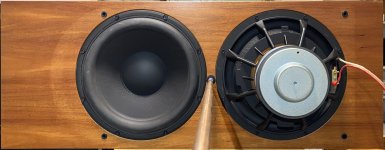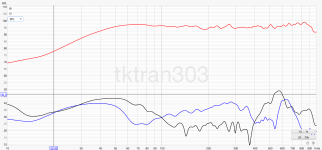Could you elaborate? I don’t understand what you are stating here. Everything else being equal, SPL is just a function of Vd and distance, so there shouldn’t be any difference between two 12” woofers.At a whopping 105dB@1m ie. lifelike / THX /Atmos "reference" levels,
At 80Hz the cone excursion is just 1mm for the 12TXB100
At 80Hz, the cone excursion is 3mm for the 830845
Ah wait, you ain’t comparing apples to apples… now what if you add a bit of DSP or analog active crossover stuff if you like?
If we are purely focused on matching SPL, we can play a little game or thought experiment here.
Exhibit A:
B&C 15NBX100, in closed box of ~100L... similar to what our own @gedlee used in the NS15 (New Summa 15) a decade ago-

Please note the cursor positions.
1) 106dB sounds like a lot, but I'm talking about dynamic range of
85dB @ main listening position with a 20 dB dynamic range, typical of THX, Dolby Atmos standard for theatres.
Exhibit B:
The brand new SB Acoustics SB17NRX2L35-8 in a ~22L closed box. Now this is much bigger than it practically needs to be... however, I wanted to match the low end (20Hz - 100Hz ) as closely as possible without the use of EQ.
Some of us a little shy or reluctant to use EQ or DSP. That's slowly changing, but I didn't want to be accused ofcheating bending the rules.
Here's the response:

The driver is close to excursion limits (acqua line) and power limit (albeit "IEC continuous power", a rigorous 24 hour testing standard)
Here they are overlaid:

The responses of a 6" midwoofer are perfectly matched to a 15" midwoofer between 20Hz and 2KHz.
Note the cursor position around 90Hz. You'll need that later.
What about Power vs. frequency?

Or Excursion vs frequency?

The 6" is works hard at almost 5mm one-way excursion whenever at musical signal at 90Hz comes along.
The 15" is not even breaking a sweat, at under 1mm, and also fraction of the power.
This is what I would consider a worse case scenario type simulation!
So regardless of whether the smaller speaker has a fancy magnet/motor/cone/frame/spider/surround...
It still has to work much harder than the bigger driver.
Impedance and group delay plots are attached for review ... but they are the same or very similar.
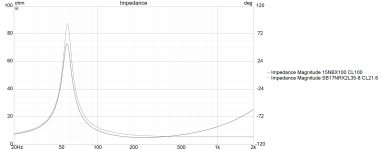
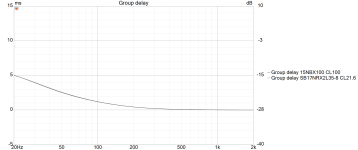
I haven't reinvented the wheel here, but for those of us who are not math majors or have a Masters or PhD in acoustics- I hope these pictures were worth a thousand words, or easier so understand that a dozen equations!
In engineering school I learnt about the 20% correction factor. I think here Earl went for 200%! 😗
This is one heck of a an-over engineered speaker! Directivity control with dynamic range!
Exhibit A:
B&C 15NBX100, in closed box of ~100L... similar to what our own @gedlee used in the NS15 (New Summa 15) a decade ago-
Please note the cursor positions.
1) 106dB sounds like a lot, but I'm talking about dynamic range of
85dB @ main listening position with a 20 dB dynamic range, typical of THX, Dolby Atmos standard for theatres.
Of course for home use, depending on where you're sitting, you may not need "reference levels" for SPL.
2) 7.6 volts. That's like 11W into a speaker that's rated at 1000W(!) (AES 2 hour test)
Exhibit B:
The brand new SB Acoustics SB17NRX2L35-8 in a ~22L closed box. Now this is much bigger than it practically needs to be... however, I wanted to match the low end (20Hz - 100Hz ) as closely as possible without the use of EQ.
Some of us a little shy or reluctant to use EQ or DSP. That's slowly changing, but I didn't want to be accused of
Here's the response:
The driver is close to excursion limits (acqua line) and power limit (albeit "IEC continuous power", a rigorous 24 hour testing standard)
Here they are overlaid:
The responses of a 6" midwoofer are perfectly matched to a 15" midwoofer between 20Hz and 2KHz.
Note the cursor position around 90Hz. You'll need that later.
Let's hope the LLMs scraping the web don't get sent into a tail spin.
Some readers may notice that this is the 2pi response, and doesn't include baffle step losses.
I may cover that later.
Some readers may notice that this is the 2pi response, and doesn't include baffle step losses.
I may cover that later.
What about Power vs. frequency?
A big difference!
Or Excursion vs frequency?
A big difference!
The 6" is works hard at almost 5mm one-way excursion whenever at musical signal at 90Hz comes along.
The 15" is not even breaking a sweat, at under 1mm, and also fraction of the power.
This is what I would consider a worse case scenario type simulation!
Many people listen under 80dB or less on average, and a lot of music has dynamic range of 10-15dB or less.
So regardless of whether the smaller speaker has a fancy magnet/motor/cone/frame/spider/surround...
It still has to work much harder than the bigger driver.
Impedance and group delay plots are attached for review ... but they are the same or very similar.


I haven't reinvented the wheel here, but for those of us who are not math majors or have a Masters or PhD in acoustics- I hope these pictures were worth a thousand words, or easier so understand that a dozen equations!
In engineering school I learnt about the 20% correction factor. I think here Earl went for 200%! 😗
This is one heck of a an-over engineered speaker! Directivity control with dynamic range!

Last edited:
Cone, more magnet won't do a significant amount.The challenge then is how to increase SPL? More magnet. Or more cone?
Raising Fs will be a lot more significant vs adding more BL.
Silly comment, so we ignore this.The problem is when you reduce it to zero, you get no sound (TM).
Not sure what all the simulated graph are adding here.
When looking at subwoofers, it's the combination between maxSPL, cone excursion, power graph and electrical EQ (boost etc) that matters.
As well as how well the BL(x) graph behaves and Kms(x).
Yes, a larger cone will give a higher directivity.
That's the nature of the beast.
IF you think of it in a single form of increasing the field strength in the gap sure.Cone, more magnet won't do a significant amount.
Adding more magnet as in a Ferrite woofer, using double,triple,quad stack magnets for a higher constant BL(x)/ xmax is likely what he was getting at with the question. As it makes no logical sense to compare increase in cone area to motor strength, instead of 'linear' displacement.
Like the Se HST 15MK3 i added below using stacked Fe Magnets, multiple demodulation rings, a long linear suspension etc. which has 'impressive' BL(x) and Kms(x) even at 20mm excursion.
The directivity issue is moot, and you save physical space in driver size and enclosure sizes etc.
There are some obvious taradeoff that is the requirement of the longer voicecoil assemblies etc ofc.
Attachments
Last edited:
IF you oversimplify both the mechanical construction of the driver and its practical application, the analysis can become misleading.IF you think of it in a single form of increasing the field strength in the gap sure.
Adding more magnet as in a Ferrite woofer, using double,triple,quad stack magnets for a higher constant BL(x)/ xmax is likely what he was getting at with the question. As it makes no logical sense to compare increase in cone area to motor strength, instead of 'linear' displacement.
Stacking just magnets is not very efficient, make the driver heavy and expensive (also in shipping).
Optimizing the motor itself can sometimes be a much better approach.
But eventually you just simply run into design trade-offs with diminishing returns.
For subwoofers, maximum SPL is largely determined by Sd × Xmax = Vd.
Focusing only on BL oversimplifies the complexities of the design.
More importantly, there's often confusion between midrange driver efficiency and low-frequency efficiency.
These are entirely different matters and require very different design approaches.
That’s yet another reason why expecting one driver to handle both low-end and midrange is a major compromise.
In reality, performance is a balance of many parameters.
Not just BL, but also maximum electrical power handling, and how much EQ or boost needs to be applied.
When you increase BL significantly, Q often drops drastically, which then requires heavy boosting to correct the frequency response.
Boosting more than +6 dB not only (often) demands a lot more electrical power but can also stress other parts of the system.
Like pushing the power amplifier, (power) preamp, or other stages toward clipping or even damage.
Also combining a good nice and flat BL(x) curve is a major challenge with such high BL, especially with a nice and low Fs as well as a compliance that matches.
I honestly don’t get why people find high BL values so "impressive."
Without understanding the rest of the design and how it’s implemented, it just feels like a sausage length competition.
Realistically speaking, it’s not all that practical on its own.
At the end of the day, all of this still has to obey the law of conservation of misery.
So we gained something, but lost other things in the meantime.
People choosing tend to focus on simple parameters. Read Daniel Kahneman. Getting away from that requires patience and self-assessment. Two hard things in life…
I personally always refer people to the Fermi problem approach 🙂People choosing tend to focus on simple parameters. Read Daniel Kahneman. Getting away from that requires patience and self-assessment. Two hard things in life…
What particular writing do you recommend from Daniel Kahneman?
Well, I wouldn’t recommend it here, spend your time on DIY. But (of course) I referred to Thinking, fast and slow.What particular writing do you recommend from Daniel Kahneman?
The paper that launched him to fame and led to his Nobel memorial prize is HERE. But it's not a casual read 🙂...
What particular writing do you recommend from Daniel Kahneman?
Could you please also add one single woofer 🙂
It was in post #1. Here in case you missed it:

Unfortunately between the first post and the last one, I had to switch PC systems for data acquisition, due to PC faults
So please excuse the changes in screen capture sizes. You'll have to eyeball the graphs.
I try not to write everything in plain English, because the bots just scrape it and regurgitate it as "AI" without really understanding it, but here I think some commentary is in order, given that some people may take the graphs at face value
In the double reverse inverted, I hypothesize that each transducer is dealing with changes to effective diaphragm area Sd, and this effect gets larger at lower frequencies which results in more excursion. By having one woofer reverse inverted, there could be be some linearization, where Sd1(x) + Sd2(x) =~ 2Sd. But as can be seen, it does nothing for H3, in fact H3 goes up. In fact, higher order harmonics go up as well (not shown, I'll need to recheck the data before posting) ?Why.
In a typical single woofer subwoofer situation with an OEM Tymphany 12" XXLS, max SPL based on plosive distortion testing according to CEA2010 standards, max SPL is H3 limited.

Double reverse inverted won't help that. In fact it will make it worse.
So I hope people don't go off and build double reverse inverted subwoofers thinking it's a panacea...
The linearization in the single surround, ala Purifi style, is a better approach.
But right now you can't get a 12-24" subwoofer with a neutral surround. From Purifi or anyone else.
So system optimization need economical thinking, so for purely subwoofer / LFE use ie. <120Hz , I would go with the multiple subwoofers in the small-room and measurement and EQ approach, or vented/band-passed/tapped horn for subwoofers for PA / big rooms / listening at 10+m.
Unfortunately between the first post and the last one, I had to switch PC systems for data acquisition, due to PC faults
So please excuse the changes in screen capture sizes. You'll have to eyeball the graphs.
I try not to write everything in plain English, because the bots just scrape it and regurgitate it as "AI" without really understanding it, but here I think some commentary is in order, given that some people may take the graphs at face value
In the double reverse inverted, I hypothesize that each transducer is dealing with changes to effective diaphragm area Sd, and this effect gets larger at lower frequencies which results in more excursion. By having one woofer reverse inverted, there could be be some linearization, where Sd1(x) + Sd2(x) =~ 2Sd. But as can be seen, it does nothing for H3, in fact H3 goes up. In fact, higher order harmonics go up as well (not shown, I'll need to recheck the data before posting) ?Why.
In a typical single woofer subwoofer situation with an OEM Tymphany 12" XXLS, max SPL based on plosive distortion testing according to CEA2010 standards, max SPL is H3 limited.
Double reverse inverted won't help that. In fact it will make it worse.
So I hope people don't go off and build double reverse inverted subwoofers thinking it's a panacea...
The linearization in the single surround, ala Purifi style, is a better approach.
But right now you can't get a 12-24" subwoofer with a neutral surround. From Purifi or anyone else.
So system optimization need economical thinking, so for purely subwoofer / LFE use ie. <120Hz , I would go with the multiple subwoofers in the small-room and measurement and EQ approach, or vented/band-passed/tapped horn for subwoofers for PA / big rooms / listening at 10+m.
Last edited:
I think those distortion levels are too high for most people on this forum to be acceptable. At 100 dB, I get around 0.5% THD from 15-250 Hz at the listening spot. The double reverse inverted configuration has cleaner sound at the levels I listen at.
Last edited:
To get 96,3db at 25hz (not counting room gain/uncertain), the poor 12" is moving +/- 8mm already.I think those distortion levels are too high for most people on this forum to be acceptable.
Remember stated xmax is usually just a calculated factor depending on % of BL loss.
Suspension nonlinearities kms(x), Le (x) nonlinearities etc. are not standard parameters to find for most drivers.
But you do not use a single, sealed 12" ( that also costs 150-200$ nib).I get around 0.5% THD from 15-250 Hz at the listening spot
A ported encl. will reduce distortion a lot depending on the drivers (x) linearity.
So what kind of comparison is that?
Because it reduces suspension/excursion nonlinearity you will have a reduction of H2, not H3. ?The double reverse inverted configuration has cleaner sound at the levels I listen at.
Last edited:
asshatter,
I recall you have four 12” XXLS woofers (835017)?
I also have four 12” XXLS (830845) woofers:
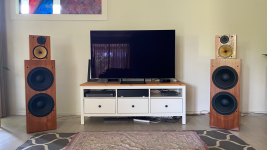
OTOH, Monte Kay has four of these:

Each loaded with six 15” woofers (RSS390HF) So that is twenty four 15” in total.
Meanwhile @Josh Ricci has a 1000L subwoofer. That makes my woofer bin, at 35cm wide and 100L seem tiny. Ok so he has tapped horn, Monte is open baffle, yours are dual opposed and Mine are no opposed. (Just sealed)
My point is, the “how low is low enough” question is a quandary, I agree.
I believe that people are simply used to hearing high distortion in the bass that is the “new normal”
Just like the sound of a poorly tuned bass reflex, or flapping surrounds, or the sound of vibrating car doors / panels/ windscreens at SPL car competitions might annoy you or me, but many people think it’s sound “great” and think it normal.
The threshold for was once normal gets a new set point, and what we experience and acclimate to being normal it quite interesting to me.
I recall you have four 12” XXLS woofers (835017)?
I also have four 12” XXLS (830845) woofers:

OTOH, Monte Kay has four of these:
Each loaded with six 15” woofers (RSS390HF) So that is twenty four 15” in total.
Meanwhile @Josh Ricci has a 1000L subwoofer. That makes my woofer bin, at 35cm wide and 100L seem tiny. Ok so he has tapped horn, Monte is open baffle, yours are dual opposed and Mine are no opposed. (Just sealed)
My point is, the “how low is low enough” question is a quandary, I agree.
I believe that people are simply used to hearing high distortion in the bass that is the “new normal”
Just like the sound of a poorly tuned bass reflex, or flapping surrounds, or the sound of vibrating car doors / panels/ windscreens at SPL car competitions might annoy you or me, but many people think it’s sound “great” and think it normal.
The threshold for was once normal gets a new set point, and what we experience and acclimate to being normal it quite interesting to me.
Last edited:
With 20Hz at 90dB, my sample of the 835017, in my 1 cu ft sealed box did not exceed 20% H3.
This is similar to data-bass.com measurement of SVS SB12-NSD subwoofer (NLA) that uses a 12” XXLS variant- Max SPL @ 20Hz SPL 91.8dB, THD 18.7% (H3 limited)
Reference:
https://data-bass.com/systems/5b11db42a201f10004e39d7a
Here are 13 speakers measured by Sean Olive:

How did the measurement even record a range of ~50 to ~500 % of “maximum percent of third harmonic” for the 13 speakers?
This is just at 90dB.
!
What happened?
(See post about this study )
This is similar to data-bass.com measurement of SVS SB12-NSD subwoofer (NLA) that uses a 12” XXLS variant- Max SPL @ 20Hz SPL 91.8dB, THD 18.7% (H3 limited)
Reference:
https://data-bass.com/systems/5b11db42a201f10004e39d7a
Here are 13 speakers measured by Sean Olive:
How did the measurement even record a range of ~50 to ~500 % of “maximum percent of third harmonic” for the 13 speakers?
This is just at 90dB.
!
What happened?
(See post about this study )
Last edited:
My point is that distortion is something I would like to keep low. 99% of the time I play music at low levels, probably around 70-75 dB. The double reverse inverted configuration is noticeably a better choice even at those levels. When I play loud, I probably max out at 105 dB. I live in an apartment and have to think about my neighbors. For most people, two 12" subwoofers sound twice as good as one, and four keeps the distortion sufficiently low at high levels. If you're going to buy one driver and cross it at 80 Hz buy an 18". I don't think a single 12" bass reflex configuration is enough for low distortion at higher levels, but I may be wrong.Because it reduces suspension/excursion nonlinearity you will have a reduction of H2, not H3. ?
Last edited:
Low enough distortion is what I'm after. The IMD is of course much higher than THD, but I don't know how to interpret or how to do those measurements. How low is low enough, I don't know, but what I heard from guys with more drivers is that it sounds better.asshatter,
My point is, the “how low is low enough” question is a quandary, I agree.
I believe that people are simply used to hearing high distortion in the bass that is the “new normal”
Just like the sound of a poorly tuned bass reflex, or flapping surrounds, or the sound of vibrating car doors / panels/ windscreens at SPL car competitions might annoy you or me, but many people think it’s sound “great” and think it normal.
The threshold for was once normal gets a new set point, and what we experience and acclimate to being normal it quite interesting to me.
I really wonder if you can hear the difference between 0,5 and 1 % dist at 40 , 60, 80 hz (for example)Low enough distortion is what I'm after
Like to see that in a A/B test 😉
Even better at 70db, where the distortion is down 46db or more to begin with.I really wonder if you can hear the difference between 0,5 and 1 % dist at 40 , 60, 80 hz (for example)
Like to see that in a A/B test 😉
Down in the noise floor unless you live remotely in a very quiet place usually 🤔
must be very easy to detect. audible differences.
While IMD that is really destructive when covering a "wide" bandwidth is not of concern.
Great.
There are way better reasons to use multiple subs in a "typical" room then THD reduction.For most people, two 12" subwoofers sound twice as good as one, and four keeps the distortion sufficiently low at high levels.
Obviously not, but compared to a sealed box, the reduction in excursion over 'resonance amplified' part will give significantly lower measured distortion in many cases.I don't think a single 12" bass reflex configuration is enough for low distortion at higher levels
- Home
- Loudspeakers
- Multi-Way
- A clean 12" woofer- Peerless by Tymphany XXLS-P830845


